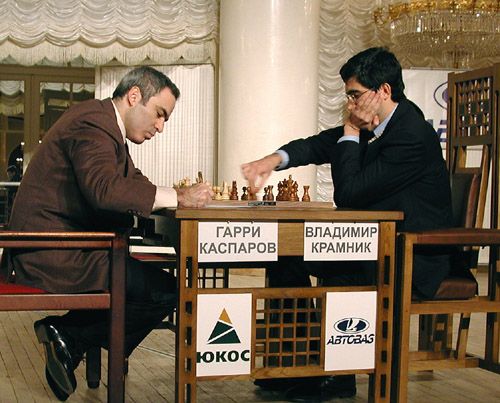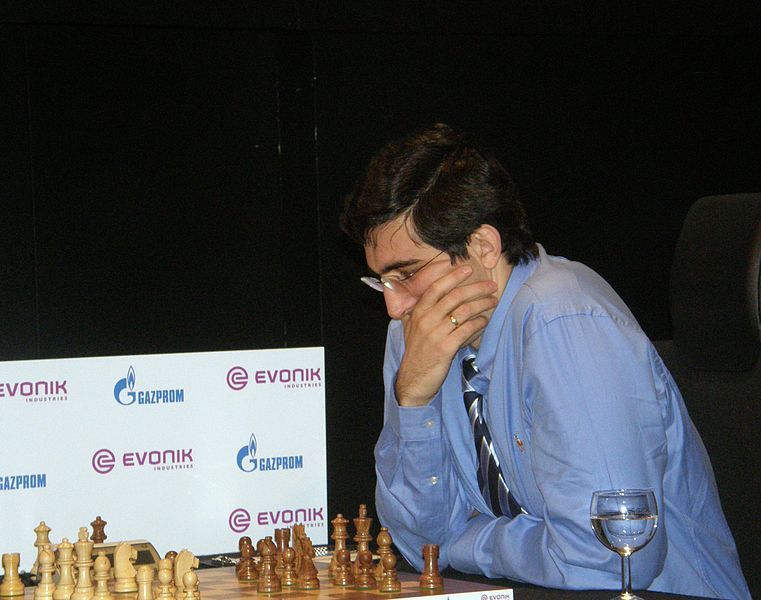GM Vladimir Kramnik

Bio
Vladimir Kramnik is the only world chess champion born in the 1970s, holding the classical title from 2000-06 and the undisputed title from 2006-07. He spent more than two decades as one of the very top players in chess before retiring in January 2019 at the age of 43.
- Early Life And Career
- Classical World Champion
- Undisputed World Champion
- Post-Championship Career
- Legacy
Early Life And Career
Vladimir Kramnik was born in Tuapse, Russia (then Soviet Union), in 1975. A student of the GM Mikhail Botvinnik school, he won the 1991 Youth Championship.
Before leaving his teens, Kramnik was already a top-flight player. In 1993, at the age of 18, he played at the Linares tournament and finished fifth of 14 in a field that included GMs Garry Kasparov, Anatoly Karpov, and Viswanathan Anand. At the next Linares tournament, Kramnik defeated Kasparov for the first time, but not the last.
Kramnik’s meteoric rise led to his tying for first on the FIDE rating list in January 1996. However, throughout the 1990s he never played in a world championship match. He lost Candidates Tournaments in both the FIDE and standard chess cycles in 1994, and fell in the quarterfinal of FIDE’s 1999 knockout championship tournament.

In the late 1990s, Kramnik, Anand, and GM Alexei Shirov were considered the top three potential challengers for Kasparov’s championship. After losing to Kasparov in 1995, Anand returned to FIDE’s championship system, while Kramnik and Shirov played a match in 1998 for the right to challenge Kasparov. Kramnik lost, but negotiations between Kasparov and Shirov eventually fell through.
Ultimately, Kramnik did not need to win a tournament or a match to play for the world championship, as without doing so he nonetheless successfully negotiated a match with Kasparov. However, Kramnik was rated ahead of Shirov by the time the 2000 match began.
Classical World Champion
Kasparov entered the match a favorite, even though Kramnik was in top form and had more than held his own against Kasparov historically. But by this point Kasparov had regained the world’s number-one rating by a wide margin. Nonetheless, Kramnik would not merely justify his presence in the match; he won it.
Kramnik struck very quickly with a victory in game two. Against Kasparov’s Grunfeld Defense, Kramnik took a novel approach on moves 10 and 11, reached a favorable endgame by move 26, and took the full point on move 40.
Kramnik remained a point up until game 10. Kasparov quit the Grunfeld after game two, and in this 10th contest played the Nimzo-Indian instead. The result was a 25-move rout in favor of Kramnik, giving him a two-point lead with only six games remaining on the schedule.
Kasparov never broke through. After draws in the next five games, the match was over. Kramnik was the first challenger since Jose Capablanca in 1921 to avoid losing a game in a championship match.
As Black, Kramnik famously took up the Berlin Defense to the Ruy Lopez, by which he held draws in games one, three, nine, 11 and 13. Kasparov played 1.c4 in games five and seven and 1.d4 in game 15, also to no avail.

Kramnik, who in 2001 became the second player to achieve a 2800 rating, nearly lost his title in a 2004 match against Hungary’s GM Peter Leko. Instead, Kramnik joined Emanuel Lasker (1910), Botvinnik (1951 and '54), and Kasparov (1987) as players to remain world champion via a drawn match. (He would also be the last, as every championship match since has gone to tiebreaks in the event of an even score.) And like Lasker and Kasparov, Kramnik needed a win in the very last game to pull it off.
After winning the first game as Black, Kramnik dropped games five and eight and needed to make up a point in the last six games. Five games later, he had yet to do so.
In the 14th and final game, however, Kramnik played the Advance Variation against Leko’s Caro-Kann after having tried the main lines in game 12. By move 33, Kramnik had established ideal positions for his last two pieces, a knight on d6 and a rook on the seventh rank. He then marched his king to f6 to create a mating net and retain the championship.
Undisputed World Champion
After Leko, Kramnik’s next title defense came against GM Veselin Topalov in 2006, but this one was different. Topalov, the world number-one by rating, was FIDE’s champion, and their match would reunify the world champion title after 13 years of dispute.
It was to be a dramatic and controversial match with the nature of the controversy a rather strange one. First, Kramnik got off to a quick start, in which he won the first two games before drawing the next two.
Before game five, however, Topalov’s camp accused Kramnik of taking a “suspicious” number of bathroom breaks. As a result, it was decided that the players would use a common bathroom instead of their own private facilities, contrary to the contract. Kramnik refused to play game five, when he would have had the advantage of the white pieces. The match continued after negotiations and a return to private facilities as under the contract, but Kramnik was ruled to have forfeited the game.
After two draws, Topalov won two games to take the lead with the forfeit now making the difference. However, Kramnik recovered quickly by winning game 10 out of the Catalan Opening. Two draws later, the match went into rapid tiebreaks. After Kramnik drew game 13 as Black, White won every remaining game. Kramnik’s game 16 win proved decisive and made the game five controversy, essentially, an unfortunate curiosity.
Kramnik didn’t hold the reunified world title for long and would lose the title before he lost a match. Instead, 2007 was already planned to be an eight-player, double round-robin tournament for the world championship, and Kramnik’s 2006 win earned him Topalov’s bid into the 2007 tournament.
Kramnik played well with a second-round win over GM Alexander Morozovich and six draws in the first half of the tournament. However, a ninth-round loss to eventual sixth-place finisher Morozovich put Kramnik in a tie for third, 1½ points behind tournament leader Anand. Although Kramnik defeated his old rival Leko in the 12th round and GM Levon Aronian in the 14th and final round, Anand secured a full-point victory.
Fortunately for Kramnik, he went into the tournament knowing that if he lost, he would still get a match with the winner.
Post-Championship Career
Unfortunately for Kramnik, he did not best Anand in 2008 either. He lost three of the first six games, and the 12-game format never gave him a real chance to recover. Kramnik did salvage a win in the tenth game, but a draw in the ensuing contest ended the match.

Despite his World Championship results in 2007 and 2008, Kramnik briefly returned to the first position on FIDE’s rating list in January 2008. He would remain a consistent presence in the world top-ten for the next decade, as he had been for the previous decade and more.
Kramnik played in three Candidates Tournaments in the last ten years of his career but never again played a championship match. In 2012 he lost in rapid tiebreaks to GM Alexander Grischuk in the semifinals of an eight-player knockout format. In the 2014 double round-robin, he finished in a three-way tie for third 1½ points behind Anand (whom GM Magnus Carlsen had dethroned as champion the year before).

In 2016, Kramnik was on the outside looking in, but in 2018 he was named the wild card for the Candidates as the world number-three. Although he faded in the second half to a fifth-place finish, he brought out the magic once more in an acclaimed third-round win over Aronian.
The 2018 Candidates turned out to be one of Kramnik’s final tournaments. He publicly announced his retirement from chess after the 2019 Tata Steel tournament in January.
Legacy
Every player is judged by more than his record against a single opponent, but Kramnik’s performance against arguably the greatest player ever in Kasparov was remarkable. He not only dethroned Kasparov as world champion in 2000 but held a positive record against Kasparov in standard games. Kramnik was also the only player besides Kasparov to rank world number-one in the 20 years from 1985 to Kasparov’s retirement. Kasparov himself once compared Kramnik’s style to that of Karpov.
More broadly, Kramnik was a player comfortable in any opening and hence any position. No opening is more closely associated with Kramnik than the Berlin Defense to the Ruy Lopez, thanks to his use of it to neutralize Kasparov’s use of the white pieces in 2000, but Kramnik was equally able to respond to 1.e4 with the Sicilian or Petroff. As White, Kramnik became known for his ability to win against the King’s Indian Defense.
Any world chess champion leaves a large legacy, but as a consistent top player for 25 years, Kramnik’s legacy goes beyond merely his presence on the list of champions.


